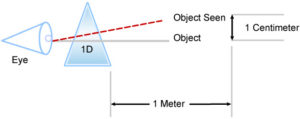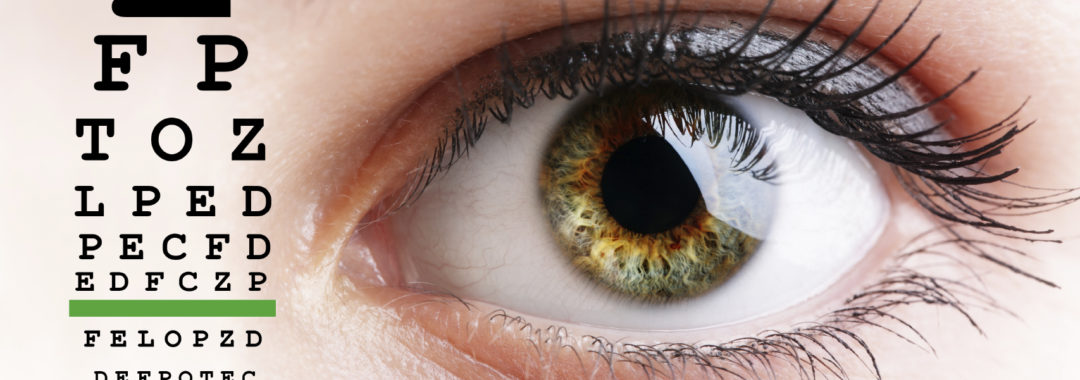Just about everyone with defective vision desires 20/20 for their distance vision. What is 20/20 vision anyway? it’s a benchmark measure of what you can see from 20 feet away.
The typical way to measure your visual acuity for distance has been using the Snellen Eye Chart. The natural vision students who want to improve their distance vision can benefit by reading the Snellen Chart.
Visual Acuity Test using Snellen Eye Chart
The Snellen Eye Chart was developed in 1982 by Herman Snellen, a Dutch ophthalmologist, to measure people’s visual acuity. In old days, you had to stand 20 feet away from the chart to measure your distance vision. Nowadays, digital (or mirror-based) Snellen charts are used to simulate 20 feet.
When you stand 20 feet away and be able to read only the line 1, your vision is 20/200. If you can read the line 8, “D E F P O T E C”, you have 20/20, normal vision. The line 1, 20/200, means if you have the normal 20/20 vision, then you can see the big E on line 1, from 200 feet away.
If you can read the lines below 20/20 from 20 feet away, you have what’s called “Super-normal” vision. Many airline or fighter pilots go through vision training to obtain super-normal vision (usually 20/10) to see details better in space when they fly the plane. Many people who practice healthy vision habits and correct their defective vision with natural vision improvement techniques are usually able to obtain 20/10.
I cannot even see the big E, on line 1, what do I do?
You can test your vision using the Snellen Eye Chart, from 10 feet, 5 feet, 4 feet, 2 feet, 1 feet, or 1/2 foot, etc. For example, you tested your vision from 10 feet and read the line 5 on the Snellen chart, then your visual acuity is 10/40. To convert to 20/20-based, you divide 20 by the distance you read from and then multiply that to the second number of the line you read. In this example, you divide 20 by 10, which is 2. Now you multiply 2 by 40 which gives you 20/80 as your current vision level.
What Is a Diopter?

For nearsighted, the diopter has minus sign on your prescription and is equal to the reciprocal of the focal length measured in 1 meter (100 cm). For example, minus 4-diopter means your blur zone starts from (100 cm / 4) 25 cm which is about 10 inches. It’s one way of measuring the distance vision but it’s not always correct. For example, a vision student, Andrea’s blurred zone started around 30 cm, about 12 inches. According this formula, her diopter should be around -3.33 (100/30), but her eye doctor prescribed -8.5 diopter glasses.
For farsighted, the diopter has plus sign on your prescription and refers to strength of the magnifying lens at one meter, about 3.3 feet away. A plus four (+4.0) diopters represent a 100% increase in magnification or 1x power magnification. A +2.0 diopter glasses provide about 50% power magnification and +12.0 diopter glasses provide approximately 5x power magnification.
Why do I need to convert to diopter?
Although eye doctors measure your visual acuity using simulated 20/20-based measurement for distance vision, diopter is what they use for prescription of your glasses/contacts (writen as Sphere; OD means right; OS means left). Thus, the glasses and contacts are manufactured based on diopter.
If you’re measuring your own visual acuity using the Snellen (or equivalent) Eye Chart and wondering what diopter you could use for your next pair of glasses or contacts, then you have to do some conversion.
Accuracy? in Visual Acuity Measurement
As you saw, it’s strange that they measure your distance vision using the Snellen Eye Chart from 20 feet (simulated) and yet the diopter is used for prescription. This is one of the reasons why the conversion from 20/20 based measurement to diopter is not straight forward.
There are also a few other factors that contribute to the difficulty of determining the accurate prescription for your corrective lenses:
- Your eyes bring the lights in and your brain interprets the image under the influence of your mind. And there’re NO tangible ways to measure your invisible mind which includes your thought, feeling, attitude, belief, and imagination.
- Your vision fluctuates from day to day, from hour to hour, and from moment to moment based on your physical, mental, and emotional state.
- If you’re getting your visual acuity measured at your eye doctor’s office, then there’re also other factors such as the lighting, the previous baseline they’re going by, who is giving you the test, white-coat fear syndrome, close proximity of tester’s face being uncomfortable (at least it was for me :), subjective questions they ask (“1 or 2?” or “3 or 4?”), etc.
No wonder why it takes a while for people to get used to their newly prescribed glasses…
Conversion of 20/20-based Measure to Diopter
The diopter given in the table below is a very rough estimate (by Todd Becker M.S.) There’s also much variation between persons, when and where you’re wearing your corrective lenses.
Conversion Table for Distance Vision
| 20/20-based Snellen | Estimated Diopter |
|---|---|
| 20/400 | -4.00 |
| 20/300 | -3.50 |
| 20/250 | -3.00 |
| 20/200 line 1 | -2.50 |
| 20/150 | -2.00 |
| 20/100 line 2 | -1.50 |
| 20/70 line 3 | -1.25 |
| 20/50 line 4 | -1.00 |
| 20/40 line 5 | -0.75 |
| 20/30 line 6 | -0.50 |
| 20/25 line 7 | -0.25 |
| 20/20 line 8 | 0.00 Normal |
| 20/15 line 9 | Super-normal |
| 20/13 line 10 | Super-normal |
| 20/10 line 11 | Super-normal |
Note: It’s strongly recommended that you get your eye doctors approval when you’re ready to reduce your prescription. It’s also important to wear glasses with at least 20/40 distance vision for driving. Please Stay Safe, especially in driving. When you receive glasses with weaker prescription, drive around familiar places first to be comfortable and build your confidence.
With love and seeing,
Mimi Shekoski, PhD, Natural Vision Teacher | Holistic Natural Health Doctor
References;
www.improveeyesighthq.com/
www.iblindness.org/3564/
www.youtube.com/watch?v=x5Efg42-Qn0
www.en.wikipedia.org/wiki/Dioptre

Having read this I thought it was extremely informative.
I appreciate you taking the time and energy to put this short article together.
I once again find myself spending a significant amount of time both reading
and commenting. But so what, it was still worth it!
Feel free to visit my page … Homemade Cell Phone Jammer
I think other web site proprietors should take this web site as an model, very clean and great user friendly style and design, as well as the content. You are an expert in this topic!
Hello,I log on to your new stuff named “20/20 Vision: How to convert 20/20 based measure to Diopters | Happy Eyesight” regularly.Your story-telling style is awesome, keep it up! And you can look our website about proxy list.
Wow, wonderful blog layout! How long have you been blogging for?
you made blogging look easy. The overall look of your web site is
wonderful, let alone the content!
I got this web page from my buddy who told me concerning
this site and now this time I am visiting this web page and reading very informative content at this place.
Unquestionably believe that which you said. Your favorite reason appeared to be
on the web the simplest thing to be aware of. I say to you, I definitely get annoyed while people think about worries
that they just don’t know about. You managed to hit the nail upon the top as well as defined out the whole thing without having
side effect , people could take a signal. Will probably be back to get more.
Thanks
Hi, all is going well here and ofcourse every one is sharing
data, that’s genuinely good, keep up writing.
Keep up the good work! Thanks.
I’m really enjoying the design and layout of your website.
It’s a very easy on the eyes which makes it much
more pleasant for me to come here and visit more often. Did you hire out
a developer to create your theme? Great work!
I’m not that much of a internet reader to be honest but your blogs really nice, keep it up!
I’ll go ahead and bookmark your site to come back in the future.
All the best
Really is so nice article, For your have share live Many Thanks
I visited many blogs except the audio feature for audio songs current at this web page is really wonderful.
Hello,I log on to your blogs named “20/20 Vision: How to convert 20/20 based measure to Diopters | Happy Eyesight” on a regular basis.Your writing style is awesome, keep doing what you’re doing! And you can look our website about free anonymous proxies.
” It’s awesome to go to see this website and reading the views of all colleagues about this post, while I am also eager of getting experience